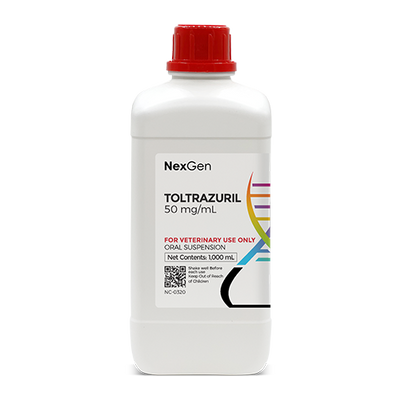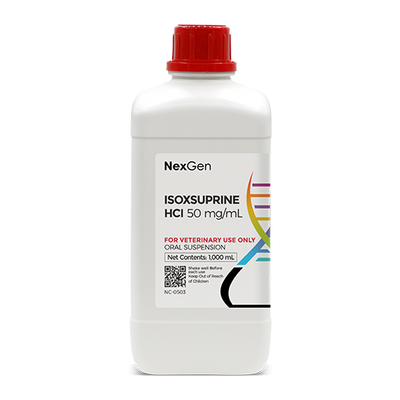
Pentoxifylline 500 mg/mL, Oral Suspension, (1000mL)
Login for pricing
- Brand
- Mixlab
- SKU:
- NC-0338
- Product Type:
- Suspension
- Size:
- 1000ml
- Administration:
- Oral
The primary cause of navicular disease is not known, although it is thought that damage to the navicular bone may occur due to interference with blood supply or trauma to the bone. This damage can occur to the deep flexor tendon, navicular bursa, or navicular ligaments, resulting in pain and lameness.3 Navicular disease causes a low grade bilateral lameness, which can occur intermittently when the horse is exercised. In some cases, one foot is affected more than the other, causing noticeable lameness. Affected horses may stand with the more painful foot in front placed of the other. A diagnosis of navicular disease is based on a combination of history, symptoms, nerve blocks and radiography. A history of intermittent or recurrent lameness is often indicative of navicular disease.2
Cutaneous vasculitis (inflammation of blood vessels) in caused by immune complexes occurring in the horse. This causes the skin to develop reddened areas that quickly erode into scabbed sores. Depending on which blood vessels are involved, the sores may appear on the legs, mouth, or lips. The limbs may also swell due to fluid accumulation under the skin. Vasculitis is usually diagnosed via tests on skin samples from the affected areas.4
Atopic dermatitis is an allergic reaction to environmental allergens such as pollens, barn dust and molds. It can occur seasonally or be present throughout the year. The three most common symptoms are urticaria (or hives), itching or pruritus alone. The latter commonly affects the face and trunk. Diagnosis of atopic dermatitis is based on clinical signs and the exclusion of other diagnoses. In some cases, a horse can have a secondary bacterial skin infection that gives rise to or exacerbates the condition.5
Endotoxemia is a serious inflammatory response to gram-negative bacteria that can lead to vital organ and circulatory system failure in horses. It often occurs after a horse has struggled with an illness such as colic, pneumonia or a severe infection. Endotoxemia can cause a horse’s vital organs to fail and its circulatory system to collapse. Symptoms of endotoxemia in horses can include lethargy, fever, dehydration, dark mucous membranes, sweating, increased heart and respiratory rate, compromised intestinal motility and pain.
The endotoxins that give rise to this condition are usually present in environments where horses reside. Horse manure typically harbors high amounts of gram-negative bacteria, making it easy for stabled horses to breathe in a significant amount of endotoxins.6
Pentoxifylline for Equines
Pentoxifylline is a hemorrheologic and immunomodulatory agent that is used in horses for the treatment of navicular disease.
NOTE: The Association of Racing Commissioners International Uniform Classification Guidelines for Foreign Substances has designated pentoxifylline as a CLASS 4 DRUG.
Where to buy Pentoxifylline
Pentoxifylline is available in the U.S. through several pharmaceutical manufacturers and through veterinary custom compounding companies.
Pentoxifylline carries several potential drug interactions. Please consult your veterinarian prior to beginning any treatment regimen.
FOR RX ONLY: A valid prescription from a licensed veterinarian is required for dispensing this medication.
3Belknap, J. K. Navicular Disease in Horses - Musculoskeletal System. Merck Veterinary Manual
4Merck Veterinary Manual.




















